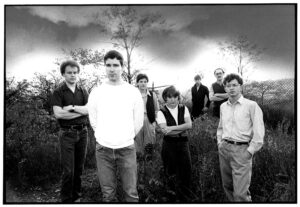 We’ve already covered the Feelies and how I fell in love with them following their return from a 16-year hiatus. But as I soon discovered, the Feelies’ road has been long and wandering, and has led down many side paths and cul-de-sacs. During their long break, there was Wake Ooloo, a band with many Feelies members that played Feelies-esque songs but which was not the Feelies; concurrent with the Feelies’ first heyday, there was Yung Wu, which was the Feelies lineup but with percussionist Dave Weckerman singing on songs that he had written. (One of these, “The Empty Pool,” ended up being covered by Yo La Tengo on their first record, which was how I first heard of it, and them.) There were the Willies, who were the Feelies performing all cover songs. And before all of this, during an early, antediluvian hiatus following the departure of the Feelies’ original rhythm section following their first album, there were the Trypes.
We’ve already covered the Feelies and how I fell in love with them following their return from a 16-year hiatus. But as I soon discovered, the Feelies’ road has been long and wandering, and has led down many side paths and cul-de-sacs. During their long break, there was Wake Ooloo, a band with many Feelies members that played Feelies-esque songs but which was not the Feelies; concurrent with the Feelies’ first heyday, there was Yung Wu, which was the Feelies lineup but with percussionist Dave Weckerman singing on songs that he had written. (One of these, “The Empty Pool,” ended up being covered by Yo La Tengo on their first record, which was how I first heard of it, and them.) There were the Willies, who were the Feelies performing all cover songs. And before all of this, during an early, antediluvian hiatus following the departure of the Feelies’ original rhythm section following their first album, there were the Trypes.
Pinning down exactly what the Trypes were, when I first heard their name back in the early days of Wikipedia, was no mean feat. They were some kind of band that was formed in the early ’80s by a group of New Jersey musicians — keyboardist John Baumgartner, flautist and vocalist Toni Paruta, bassist and vocalist Brenda Sauter, drummer Stan Demeski, guitarist Marc Francia, possibly a few others — and somehow accrued surviving Feelies guitarist/singer/songwriters Glenn Mercer and Bill Million after the initial version of that band fell apart. They released one EP, which by the time I learned about it was long out of print, and then promptly split in two, with Mercer, Million, Sauter, and Demeski bringing back Weckerman to form the Feelies 2.0 (and Yung Wu), while the original Trypes (more or less) simultaneously continued as Speed the Plough. It was all dimly documented prehistory, more music trivia than anything I could ever reasonably hope to hear for myself.
And yet, no music history ever remains buried for long, especially not since the rise of Bandcamp. Soon enough, that long-ago EP had been packaged with some other rarities into an LP reissue called Music for Neighbors, and suddenly the Trypes had been elevated from myth to become another real band on my CD shelves.
So what do the Trypes sound like? They were not unlike the Feelies, moody and precise and melodic; but also not exactly like the Feelies. There were keyboards, for one thing, courtesy of Baumgartner, and woodwinds, courtesy of Paruta (latterly Toni Baumgartner after she and John married); and seemingly everyone joined in on vocals at one point or another. They similarly chose fascinating-verging-on-bizarre covers, outdoing the Feelies’ famed version of “Everybody’s Got Something To Hide Except For Me And My Monkey” with three of the closest things to deep cuts in the Beatles catalog: “Love You To,” “The Inner Light,” and “Blue Jay Way.”
If you had told me that Music For Neighbors was a lost experimental Feelies album, I might have believed you, and you might have almost been right in a way. But it’s also arguably the first, inchoate Speed the Plough album. And, at the same time,p a glimpse of another band that never completely came to fruition, a road not taken that ended up leading in unexpected directions.
But then, everything is transitional, ultimately. For me, the mystery of the Trypes led to me discovering not just Speed the Plough but Sauter’s spinoff band Wild Carnation. I even got to see the Willies eventually, or some form of them, at an immediately legendary show in Jersey City where the band sat in armchairs and were lit by desk lamps, and which was interrupted by the fire alarm going off mid-set and the entire audience and band alike having to go stand around on the sidewalk for 20 minutes or so. A few weeks from now, I will be going to a double bill of Speed the Plough — with Glenn Mercer back in the fold, if “back” is the right word for a band he was never quite a member of in the first place — and something called Brenda+1, which is almost, but not quite, Wild Carnation. Some of my favorite art, it turns out, consists of side paths and cul-de-sacs.